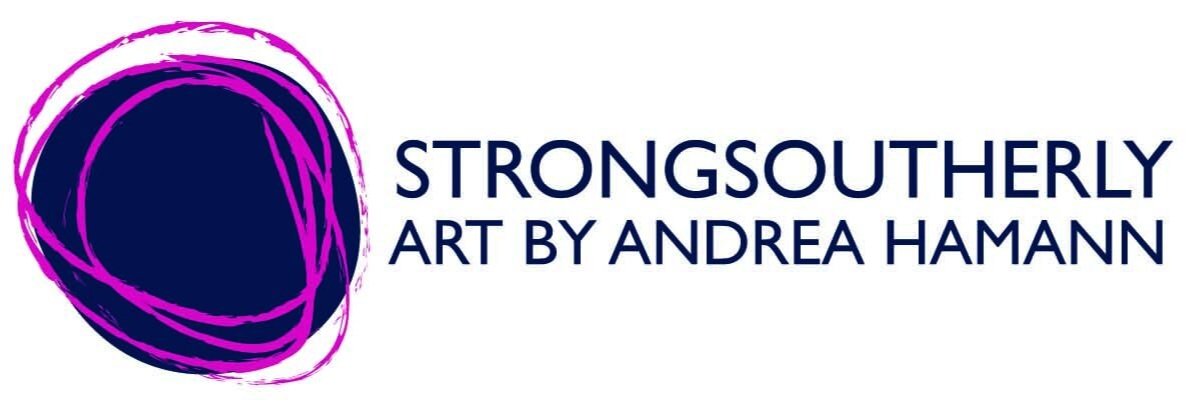Animism and Abstraction: The deceptions in the work of John Olsen.
I recently enrolled in -- and have now, very reluctantly, enrolled out of a post grad in art curation ---because they don't do online study, and i cant study from the southern highlands, and work, and be a mum and have an art practice.....
This is the first paper and only paper I wrote for the course. A short piece for a theoretical exhibition on animism and abstraction in Australian art.
Painting: Goyder Channel
Artist: John Olsen
Painted: 1975
Whether sparse and subtle like the painting Goyder Channel[1], or abundant with colour and energy, as in the painting Entrance to the seaport of desire[2], John Olsen renders the Australian landscape in a way that breaks down the form and texture of place into seductive, animistic line work. His line work is sometimes languid, sometimes energetic, all the time seeking to evoke a quality which he describes is more about the ‘feeling’ of the landscape than about pure abstraction[3].
Olsen’s abstractions of the landscape are deceptive. At first glance, paintings appear as tilted aerial landscapes, but as you move closer, elements appear in profile, in the landscape view. Goyder Channel for example, is abstracted in a way that it is simultaneously a landscape and an aerial view. Frenetic scratchy line work evokes figures, before merging with blurred, softened lines and a vast, open aerial landscape.
Where Artist Fred Williams achieves this quality with weighty dabbed marks and lines often representing a melancholic, dying landscape, Olsen’s works speak of an abundance of life, found even in the most remote landscapes. Even in the calmness of Goyder Channel Olsen’s linework evokes a quiet chaos of activity, of creatures or rivulets at the channels edge. Exploring Lake Eyre and the surrounding channel country deepened Olsen’s understanding of the Australian landscape. He was fascinated with the contrast between Lake Eyre teeming with life after the rains, and then a few weeks later, dry again, all the life suddenly in hibernation, or dead.
There are other deceptions in Olsen’s work, in all the odd little lines, dots and squiggles. Are they figures, animal eyes, or body parts posing as tree limbs or rock pools? Or are they rock pools and rivulets posing as tree limbs and animal eyes? Olsen’s linework has the singular quality of depicting the animate and inanimate simultaneously. Olsen alludes to this whilst discussing works with Amanda Houten.
"The landscape is an active force, a kind of an animal in itself. So that one," he points, "is like a dog raising up. The dog is in the landscape, but the landscape is also inside the dog. And the same applies to us. The landscape contains a spiritual essence that is part of me. I am in the landscape and the landscape is in me."[4]
These qualities are obvious in works such as ‘Five Bells’, with rich colour and complexity. However, this quality is equally evident in Goyder channel. Here there are lines that look like bird claws, but could also be tracks or creeks. There are efficient, simple lines that could be figures, people running, or skulking through the landscape. Goyder Channel, while still very much full of life, is more evocative of the peace of the Lake Eyre landscape, softer and calmer than many of Olsen’s Sydney Harbour paintings, which are busy with energy.
In contrast to Australia’s colonial Artists, Olsen goes beyond simplistic animistic representations. Unlike Glover’s work ‘Natives on the Ouse River[5], where aboriginals climb trees as if part of the landscape, the animism in Olsen’s paintings is more complete. It is intrinsic to the painting, and not patronising of an age-old culture. There is an understanding of the interconnectedness of humans with nature. If anything, Olsen’s work show kinship with contemporary aboriginal artwork, seeing rhythms and patterns in the landscape in a related way. There is no naïve tokenism in Olsen’s animist abstractions. Olsen’s own language describes this best. He visually explores all the life that is connected, all the abundance in nature, from the smallest scale to the largest. “‘Nothing too small …should escape my attention’ he wrote, ‘an insects wing, the leap of a frog, the flight patterns of dragonflies’’.[6]
[1] Olsen, John. 1975, Goyder Channel Watercolour on Paper, Australian Collection, Art Gallery of NSW, Accessed 10 April 2017, https://www.artgallery.nsw.gov.au/collection/works/15.1980/
[2] Olsen, John. 1964, Entrance to the seaport of desire, Synthetic Polymer paint on Canvas , Australian Collection, Art Gallery of NSW, Accessed 10 April 2017, https://www.artgallery.nsw.gov.au/collection/works/OA23.1968/
[3] Olsen, J. with Churcher, B. 2008, ‘An unstoppable force: Betty Churcher with John Olsen’, Video Recording, Artscape, Film Australia in association with ABC, National Film and Sound Archive
[4] Hooten, A. 2016, John Olsen: at home with the Australian artist, Good Weekend, Sydney Morning Herald, Accessed 10 April 2017, http://www.smh.com.au/good-weekend/john-olsen-at-home-with-the-australian-artist-20160819-gqwutd.html
[5] Glover, J. ca.1838. Natives on the Ouse River, Oil on Canvas, Australian Collection, Art Gallery of New South Wales, Accessed 10 April 2017, https://www.artgallery.nsw.gov.au/collection/works/48.1985/
[6] Edwards, D. 2016, The Littoral and the Void, in John Olsen: The you Beaut Country, Eds. Edwards, D. and Hurlston, D. Council of Trustees of the National Gallery of Victoria, Melbourne.p.32

